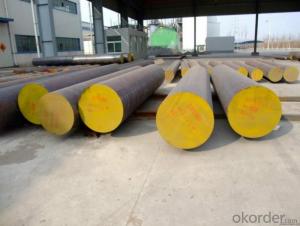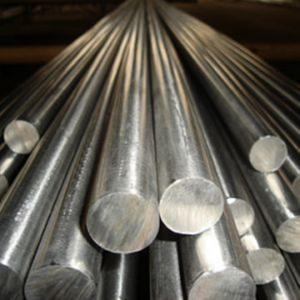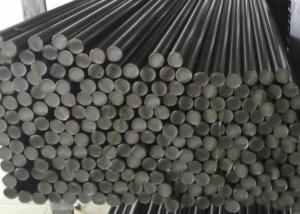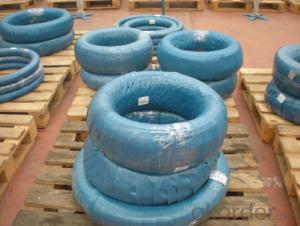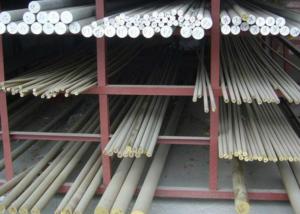AISI 1055 Round Bar Hot Rolled Carbon Steel
- Loading Port:
- Tianjin
- Payment Terms:
- TT OR LC
- Min Order Qty:
- 25 m.t.
- Supply Capability:
- 50000 m.t./month
OKorder Service Pledge
OKorder Financial Service
You Might Also Like
Item specifice
AISI 1055 Round Bar Hot Rolled Carbon Steel
Product Description:
1. Hot rolled steel round bar
2.Quality:L.F+V.D etc
3.Grade:C55 S55C CK55 1055
4.Hardness:229HB
5.Tensile strength:600MPA
6.Yield strength: 355MPA
7.elogation:16% Reduction of area:40%
Chemical Composition:
China | America | Germany | Japan | C | Si | Mn | Cr | P/S |
55B | AISI1055B | C55B | S55CB | 0.52-0.60 | 0.17-0.37 | 0.5-0.9 | ≤0.25 | ≤0.35 |
Sizes details:
Sizes details | diameter | 16-320mm |
length | 3-12m(canbe customerized) | |
Sizes tolerance | length | +/-100mm(max) |
diameter | +/-2mm(max) | |
Straightness | 3mm/m(max) |
Application:
Carbon steel rod applies to chemical industry, shipping industry,manufacturing industry, construction, decorate industry, electric power, pump shafts, sanitary wares, furniture handles, boiler, high temperature resistant,low temperature resistant,corrosion resistant
Our service:
We can supply steel round bar, square steel, the grade such as,SS400B, S20C, S45C, Ck45, SAE1020B, SAE1045B, SAE4140,SAE4150, SAE4340, SAE8620, 42CrMo4, 15B36Cr, S50C, S55C,S65C.20Cr,40Cr GCr15. The diameter is from 16mm to 320mm. It is hot rolled and Black surface. If you need, please feel free to contact me.
Products Show:


- Q:What are the safety considerations when handling special steel products?
- When handling special steel products, some important safety considerations include wearing appropriate personal protective equipment (PPE) such as gloves, safety glasses, and steel-toe boots to protect against cuts, burns, and impact injuries. It is also crucial to ensure proper lifting techniques are employed to prevent strains or back injuries. Additionally, storing the steel products in a secure and organized manner can help prevent accidents and injuries. Regular inspections of the equipment and tools used for handling the steel products should be carried out to identify any potential hazards or defects. Lastly, proper training and awareness of the specific safety protocols and procedures related to handling special steel products are essential to minimize risks and maintain a safe working environment.
- Q:Can special steel be used in medical applications?
- Yes, special steel can be used in medical applications. Special steel alloys, such as stainless steel, are commonly used in the production of surgical instruments, orthopedic implants, and medical devices due to their excellent corrosion resistance, durability, and biocompatibility properties.
- Q:How does special steel contribute to improving product performance?
- Special steel contributes to improving product performance in several ways. Firstly, special steel has superior strength and durability compared to regular steel, making it more resistant to wear, corrosion, and impact. This increased durability ensures that products made with special steel have a longer lifespan and can withstand harsh conditions, ultimately enhancing their performance and reliability. Additionally, special steel can be tailored to have specific characteristics, such as high temperature resistance or magnetic properties, which can be crucial for certain applications. By using special steel, manufacturers can create products with enhanced functionality, efficiency, and safety, ultimately leading to improved overall performance.
- Q:What are the different corrosion protection methods used for special steel?
- There are several corrosion protection methods used for special steel to ensure its durability and longevity. These methods include: 1. Coatings: Applying various types of coatings, such as paint, epoxy, or zinc, can provide a protective layer on the steel surface. These coatings act as a barrier, preventing moisture and corrosive elements from coming into direct contact with the steel. 2. Galvanization: Galvanizing is a process that involves coating the steel with a layer of zinc. This creates a sacrificial barrier, as the zinc corrodes instead of the steel. Galvanized steel is commonly used in outdoor applications, such as fences, poles, and roofing. 3. Stainless steel: Special steel can also be manufactured using stainless steel, which contains a high percentage of chromium. Chromium forms a passive layer on the surface of the steel, providing excellent corrosion resistance. Stainless steel is widely used in industries such as construction, food processing, and medical equipment. 4. Cathodic protection: This method involves creating an electrical current or using sacrificial anodes to protect the steel. By introducing a more reactive metal (sacrificial anode) or applying an electrical current, corrosion is minimized as the reactive metal corrodes instead of the steel. 5. Alloying: Modifying the composition of the steel by adding elements like nickel, molybdenum, or copper can enhance its resistance to corrosion. These alloying elements form a protective layer on the surface, making the steel more resistant to rust and other forms of corrosion. 6. Passivation: Passivation is a chemical process that removes free iron from the surface of the steel and forms a protective oxide layer. This layer acts as a barrier against corrosion, enhancing the steel's resistance to rust and other forms of corrosion. 7. Proper maintenance: Regular inspection, cleaning, and maintenance of special steel are essential in preventing corrosion. Removing dirt, debris, and other contaminants from the steel's surface can help maintain its protective coatings and prevent corrosion from occurring. It is important to select the appropriate corrosion protection method based on the specific application and environmental conditions to ensure the long-term performance and durability of special steel.
- Q:What are the challenges in recycling special steel?
- Recycling special steel poses several challenges due to its unique composition and properties. Firstly, special steel is often alloyed with various elements to enhance its strength, durability, and corrosion resistance. These alloys can make the recycling process more difficult and complex compared to recycling common steel. One of the main challenges is the separation of special steel from other metals during the recycling process. Special steel may contain rare and valuable elements such as nickel, chromium, and molybdenum, which are essential for its unique properties. Separating these elements from other metals requires advanced techniques and specialized equipment, increasing the complexity and cost of recycling. Another challenge is the presence of impurities in special steel. These impurities can be introduced during the manufacturing process or through contamination during use. Removing these impurities is crucial to ensure the recycled steel meets the required specifications for its intended applications. However, the high melting point and resistance to purification of some impurities may complicate the recycling process. Furthermore, the physical characteristics of special steel, such as its high hardness and toughness, can make it challenging to handle and process during recycling. Special steel often requires more energy-intensive methods, such as shredding or melting at higher temperatures, which can increase the overall cost and environmental impact of the recycling process. Moreover, the economic viability of recycling special steel can be a challenge. The market demand for special steel may fluctuate, making it difficult for recyclers to ensure a consistent and profitable supply. Additionally, the costs associated with the collection, transportation, sorting, and processing of special steel can be higher compared to common steel, further impacting the economic feasibility of recycling. In conclusion, the challenges in recycling special steel primarily stem from its complex composition, the need for separation from other metals, the presence of impurities, the physical characteristics of the material, and the economic viability of the recycling process. Addressing these challenges requires innovative technologies, efficient separation methods, and a sustainable market demand for recycled special steel.
- Q:Can special steel be used in the electronics manufacturing industry?
- Yes, special steel can be used in the electronics manufacturing industry. Special steel alloys, such as stainless steel or high-strength low-alloy (HSLA) steel, offer excellent properties like corrosion resistance, electrical conductivity, and magnetic shielding, making them suitable for various electronic components like connectors, sensors, circuit boards, and casings. These specialized steel materials ensure durability, protection, and reliable performance in demanding electronic applications.
- Q:What are the different methods of surface laser cladding for special steel?
- There are several different methods of surface laser cladding that can be used for special steel. One common method is powder-based laser cladding. In this process, a powder material is injected into the laser beam, which melts and fuses with the surface of the special steel. The powder material can be chosen to provide specific properties such as enhanced hardness or corrosion resistance. This method allows for precise control over the thickness and composition of the cladding layer. Another method is wire-based laser cladding. In this process, a wire material is fed into the laser beam, which melts and fuses with the special steel surface. Wire-based laser cladding is often used for larger areas or when a thicker cladding layer is required. It is also commonly used for repairing or salvaging worn or damaged parts. A third method is direct energy deposition (DED) laser cladding. This method involves using a laser beam to melt a powder or wire material as it is being deposited onto the special steel surface. DED laser cladding allows for rapid build-up of multiple layers and is often used for additive manufacturing or repairing high-value components. Each method of surface laser cladding has its own advantages and limitations, and the choice of method depends on factors such as the desired cladding thickness, material properties, and the specific requirements of the application.
- Q:What are the applications of special steel in the power generation supply chain?
- Special steels have several applications in the power generation supply chain. They are commonly used in the construction of turbines, boilers, and other critical components of power plants. These steels possess high strength, corrosion resistance, and heat resistance properties, making them suitable for the demanding conditions within power generation facilities. Special steels also play a crucial role in the manufacturing of transmission and distribution equipment, such as transformers and generators, ensuring efficient and reliable power transmission. Overall, the applications of special steel in the power generation supply chain contribute to the development of robust and sustainable energy infrastructure.
- Q:What are the non-destructive testing methods used for special steel?
- There are several non-destructive testing (NDT) methods that are commonly used for special steel. These methods are designed to detect flaws or defects in the steel without causing any damage to the material. One of the most widely used NDT methods for special steel is ultrasonic testing. This technique involves sending high-frequency sound waves through the steel and analyzing the echoes that are reflected back. By measuring the time it takes for the sound waves to travel through the steel and return, technicians can determine the thickness, density, and internal structure of the material. Ultrasonic testing is particularly effective at detecting cracks, voids, or inclusions in the steel. Another commonly used NDT method for special steel is magnetic particle testing. This technique involves applying a magnetic field to the surface of the steel and then coating it with a magnetic powder. Any defects or irregularities in the steel will create magnetic flux leakage, causing the magnetic particles to cluster and form visible indications. This method is particularly effective at detecting surface cracks or discontinuities in the steel. Liquid penetrant testing is another NDT method that is often used for special steel. This technique involves applying a liquid dye or fluorescent material to the surface of the steel. The dye penetrates any surface cracks or defects, and after a specified dwell time, excess dye is removed. A developer is then applied, which draws out the dye from any flaws, making them visible under UV light. This method is effective at detecting surface discontinuities and is commonly used in the aerospace and automotive industries. Radiographic testing is another NDT method that can be used for special steel. This technique involves exposing the steel to X-rays or gamma rays and capturing the resulting image on a film or digital detector. By analyzing the radiographic image, technicians can detect internal flaws such as cracks, voids, or inclusions in the steel. This method is particularly useful for thicker sections of steel or when access to the material is limited. In conclusion, non-destructive testing methods such as ultrasonic testing, magnetic particle testing, liquid penetrant testing, and radiographic testing are commonly used for special steel. These methods allow for the detection of flaws or defects in the steel without causing any damage to the material, ensuring its integrity and reliability.
- Q:What are the different methods for quenching special steel?
- Quenching is a critical step in the heat treatment process of special steel, as it helps to achieve the desired mechanical properties and improve the material's hardness and strength. There are several methods for quenching special steel, each with its own advantages and considerations. 1. Oil Quenching: This is one of the most commonly used methods for quenching special steel. The steel component is immersed in oil, which acts as a cooling medium. Oil quenching provides a moderate rate of cooling, allowing for controlled and uniform hardening. It is suitable for a wide range of steel grades and can prevent cracking or distortion. 2. Water Quenching: Water quenching is a faster cooling method compared to oil quenching. It provides rapid heat extraction, resulting in higher hardness and strength. However, the high cooling rate can also lead to increased risk of cracking or distortion, especially with thicker sections. Water quenching is commonly used for low-alloy steels and some high-alloy steels. 3. Polymer Quenching: Polymer quenching involves using a specialized polymer solution as the cooling medium. This method provides a controlled cooling rate, offering a balance between the slower oil quenching and faster water quenching. Polymer quenching can be particularly suitable for steels with complex shapes or critical dimensions, as it reduces the risk of distortion and cracking. 4. Air Quenching: Air quenching is a slower cooling method that involves allowing the steel component to cool in ambient air. It is typically used for steels with lower hardenability, as it provides a more gradual cooling rate. Air quenching can help to reduce the risk of distortion and cracking, but it may result in lower hardness and strength compared to other quenching methods. 5. Salt Bath Quenching: Salt bath quenching involves immersing the steel component in a molten salt bath as the cooling medium. This method provides a controlled and uniform cooling rate, reducing the risk of distortion and cracking. Salt bath quenching is particularly suitable for complex-shaped or delicate parts, as it minimizes the thermal stress during cooling. It is important to note that the choice of quenching method depends on various factors, such as the steel grade, desired hardness, component size and shape, and the required mechanical properties. Proper selection and implementation of the quenching method are crucial to achieving the desired material characteristics and ensuring the overall quality of the special steel product.
1. Manufacturer Overview |
|
|---|---|
| Location | |
| Year Established | |
| Annual Output Value | |
| Main Markets | |
| Company Certifications | |
2. Manufacturer Certificates |
|
|---|---|
| a) Certification Name | |
| Range | |
| Reference | |
| Validity Period | |
3. Manufacturer Capability |
|
|---|---|
| a)Trade Capacity | |
| Nearest Port | |
| Export Percentage | |
| No.of Employees in Trade Department | |
| Language Spoken: | |
| b)Factory Information | |
| Factory Size: | |
| No. of Production Lines | |
| Contract Manufacturing | |
| Product Price Range | |
Send your message to us
AISI 1055 Round Bar Hot Rolled Carbon Steel
- Loading Port:
- Tianjin
- Payment Terms:
- TT OR LC
- Min Order Qty:
- 25 m.t.
- Supply Capability:
- 50000 m.t./month
OKorder Service Pledge
OKorder Financial Service
Similar products
New products
Hot products
Related keywords
